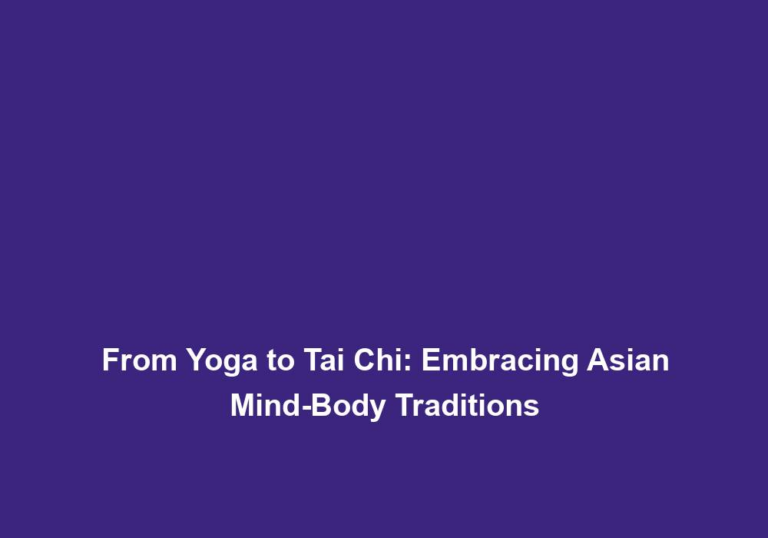Yoga Unveiled: Discovering the Rich Tapestry of Practices
Yoga is an ancient practice that has gained immense popularity worldwide in recent years. With its roots in Indian philosophy and spirituality, yoga offers a diverse range of practices that go beyond just physical exercise. In this article, we will delve into the rich tapestry of yoga practices, exploring their origins, benefits, and how they can be incorporated into our daily lives.
The Origins of Yoga
Yoga dates back thousands of years and has its origins in ancient India. The word yoga is derived from the Sanskrit word yuj, which means to unite or join. It encompasses a holistic approach to the union of mind, body, and spirit. The ancient sage Patanjali is often credited with compiling the Yoga Sutras, a collection of texts that outline the philosophy and practices of yoga.
Yoga originated as a spiritual practice, aiming to achieve a harmonious connection between the individual self and the universal consciousness. It was believed that through the practice of yoga, one could attain liberation from the cycle of birth and death and achieve self-realization. Over time, yoga evolved to include various physical postures, breathing techniques, meditation, and ethical principles.
The Eight Limbs of Yoga
Yoga is not solely focused on physical postures, also known as asanas. It encompasses a more comprehensive system known as the Eight Limbs of Yoga, as outlined by Patanjali. These limbs provide guidance on how to live a balanced and fulfilling life. Let’s explore each of these limbs:
-
Yamas: These are ethical principles and guidelines for social behavior. They include non-violence (ahimsa), truthfulness (satya), non-stealing (asteya), continence (brahmacharya), and non-greed (aparigraha).
- Practicing non-violence involves treating all beings with kindness and compassion. This extends to avoiding harm towards oneself and others, both in physical and verbal actions.
- Truthfulness encourages honesty and integrity in all aspects of life. It involves speaking the truth and living authentically.
- Non-stealing promotes respecting the property and belongings of others. It encourages contentment and the avoidance of greed.
- Continence refers to the moderation and control of one’s desires and impulses. It involves practicing self-discipline and cultivating a balanced approach to pleasure.
- Non-greed emphasizes the importance of letting go of attachments and material possessions. It encourages living with simplicity and contentment.
-
Niyamas: The niyamas are personal observances that promote self-discipline and inner growth. They include cleanliness (saucha), contentment (santosha), self-discipline (tapas), self-study (svadhyaya), and surrender to a higher power (ishvara pranidhana).
- Cleanliness involves maintaining physical cleanliness as well as cleanliness in thoughts and actions. It promotes a sense of purity and clarity.
- Contentment cultivates an attitude of gratitude and satisfaction with what one has. It involves finding joy in the present moment and avoiding excessive desires.
- Self-discipline encourages self-control and the ability to overcome obstacles. It involves making conscious choices that align with one’s values and goals.
- Self-study involves introspection and self-reflection. It includes the study of sacred texts, contemplation, and self-awareness.
- Surrender to a higher power refers to acknowledging and surrendering to a force greater than oneself. It involves letting go of the ego and trusting in the divine.
-
Asanas: Asanas refer to the physical postures practiced in yoga. They help strengthen and stretch the body, improve flexibility, balance, and overall physical well-being.
- Asanas are a way to connect the mind and body through movement and breath. They promote physical strength and flexibility while also cultivating mental focus and relaxation.
- Each asana has specific benefits for different parts of the body. For example, forward bends stretch the hamstrings and lower back, while backbends open the chest and increase spinal flexibility.
- Regular practice of asanas can improve posture, increase energy levels, and alleviate physical discomfort or pain. It also helps to develop body awareness and mindfulness.
-
Pranayama: Pranayama involves breath control techniques that help channel and enhance the flow of life force energy (prana) throughout the body. It promotes mindfulness, relaxation, and clarity of mind.
- Pranayama techniques involve conscious regulation of the breath, such as deepening or elongating the inhalation and exhalation, retaining the breath, or alternating nostril breathing.
- By regulating the breath, pranayama helps to calm the mind, reduce stress, and increase focus and concentration.
- It also enhances the flow of oxygen and vital energy in the body, promoting overall well-being and vitality.
-
Pratyahara: Pratyahara is the withdrawal of the senses from external distractions. It allows practitioners to turn their attention inward and cultivate a greater sense of self-awareness.
- In our daily lives, we are often bombarded with sensory stimuli that can lead to overstimulation and scattered attention. Pratyahara helps to quiet the senses and create space for inner reflection.
- Through pratyahara, we become less reactive to external stimuli and develop the ability to observe our thoughts, emotions, and sensations without attachment or judgment.
- This practice of sensory withdrawal prepares the mind for deeper states of concentration and meditation.
-
Dharana: Dharana refers to concentration and single-pointed focus. Practicing dharana helps calm the mind and prepares it for deeper levels of meditation.
- Dharana involves directing the attention to a specific object of focus, such as a mantra, the breath, or a visualized image.
- By focusing the mind, dharana cultivates mental clarity, stability, and mindfulness.
- It helps to develop the ability to sustain attention and overcome distractions, leading to a state of inner stillness and concentration.
-
Dhyana: Dhyana is meditation, a state of deep contemplation and awareness. It involves sustained focus on an object, breath, or mantra, leading to a transcendental experience.
- Meditation is the practice of being fully present in the moment, without judgment or attachment.
- Through regular meditation, one can cultivate a sense of inner peace, expanded awareness, and a deeper connection to oneself and the world around them.
- It allows for the exploration of the mind, emotions, and higher states of consciousness.
-
Samadhi: Samadhi is the ultimate goal of yoga, a state of blissful union and oneness with the divine. It is a state of profound spiritual realization and liberation.
- Samadhi is a state of complete absorption and transcendence, where the individual self merges with the universal consciousness.
- It is a state of deep peace, joy, and interconnectedness, free from the limitations of the ego and the illusion of separateness.
- While samadhi is considered the culmination of the yogic journey, it is also believed that glimpses of this state can be experienced along the path of practice.
Different Styles of Yoga
Yoga has evolved over time, giving rise to various styles and approaches. Each style emphasizes different aspects of the practice, catering to different needs and preferences. Here are some popular yoga styles:
-
Hatha Yoga: Hatha yoga focuses on physical postures and breath control. It is a gentle and accessible style suitable for beginners.
- Hatha yoga classes typically include a combination of asanas, pranayama, and relaxation techniques.
- The emphasis is on proper alignment, breath awareness, and mindful movement.
- Hatha yoga is a great starting point for those new to yoga or seeking a balanced practice that integrates physical and meditative aspects.
-
Vinyasa Yoga: Vinyasa yoga is dynamic and flowing, linking breath with movement. It builds strength, flexibility, and endurance.
- Vinyasa classes are characterized by a seamless flow of postures, synchronized with the breath.
- The practice is often vigorous and can be physically challenging, as it involves continuous movement and transitions between poses.
- Vinyasa yoga offers a creative and energizing practice that cultivates a sense of flow and mindfulness.
-
Ashtanga Yoga: Ashtanga yoga is a more vigorous and structured style that follows a specific sequence of poses. It promotes strength, flexibility, and detoxification.
- Ashtanga yoga consists of a set sequence of postures, which are practiced in a flowing and dynamic manner.
- The practice is physically demanding and focuses on synchronizing breath with movement.
- Ashtanga yoga is ideal for those seeking a disciplined and intense practice that builds stamina and cultivates mental focus.
-
Iyengar Yoga: Iyengar yoga emphasizes precision and alignment in postures. It uses props like blocks and straps to assist in achieving correct alignment.
- Iyengar classes focus on proper alignment and the use of props to support the body in the poses.
- The practice is slow-paced and emphasizes holding poses for longer durations to develop strength, flexibility, and body awareness.
- Iyengar yoga is suitable for all levels and can be particularly beneficial for those recovering from injuries or with specific physical limitations.
-
Kundalini Yoga: Kundalini yoga combines dynamic movements, breathwork, chanting, and meditation to awaken and balance the energy within the body.
- Kundalini classes are designed to activate the Kundalini energy, which is believed to reside at the base of the spine.
- The practice involves a combination of physical postures, breathwork, chanting, and meditation.
- Kundalini yoga aims to awaken the dormant energy within and promote spiritual growth and self-awareness.
-
Bikram Yoga: Bikram yoga is practiced in a heated room and follows a fixed sequence of 26 poses. The heat helps increase flexibility and detoxification.
- Bikram classes are conducted in a room heated to approximately 105 degrees Fahrenheit, with high humidity.
- The practice consists of a set sequence of poses, which are performed in the same order in each class.
- Bikram yoga is known for its intensity and physical challenge, as well as its potential benefits for detoxification and increased flexibility.
-
Yin Yoga: Yin yoga is a slow-paced style that focuses on long-held poses to target deep connective tissues. It promotes relaxation and increased flexibility.
- Yin classes involve passive stretching and holding poses for an extended period, typically three to five minutes.
- The practice targets the fascia, ligaments, and joints, promoting flexibility and mobility.
- Yin yoga is a gentle and introspective practice that cultivates a sense of surrender and deep relaxation.
Benefits of Yoga
The benefits of yoga extend far beyond the physical. Regular practice can have a profound impact on our overall well-being. Here are some key benefits of incorporating yoga into our lives:
-
Physical Health: Yoga improves strength, flexibility, and posture. It can help alleviate chronic pain, reduce the risk of injury, and improve cardiovascular health.
- Regular practice of yoga asanas strengthens the muscles, bones, and joints, leading to improved overall physical fitness.
- Yoga postures stretch and lengthen the muscles, increasing flexibility and range of motion.
- The practice of yoga can help to improve posture and alignment, reducing the risk of musculoskeletal imbalances and related injuries.
- Yoga also enhances cardiovascular health by improving circulation, promoting heart health, and reducing blood pressure.
-
Mental Well-being: Yoga promotes relaxation and stress reduction







